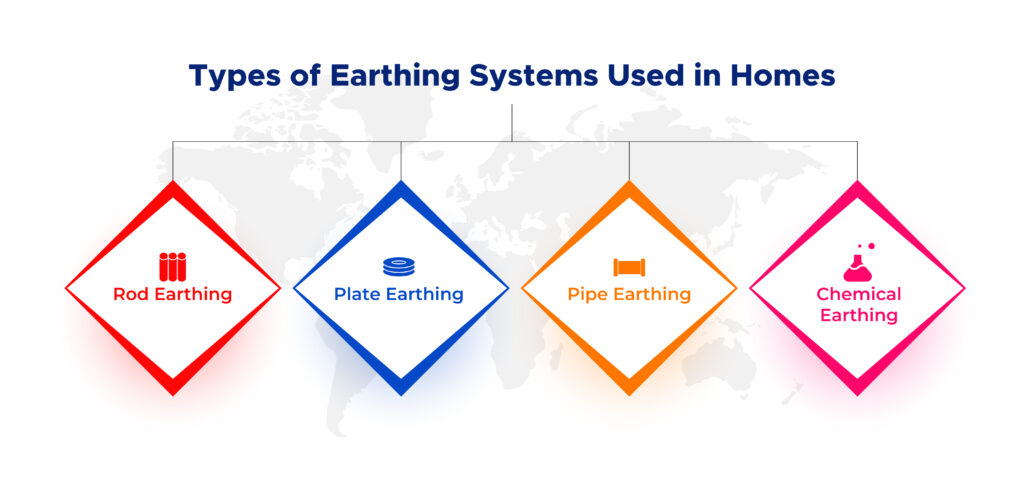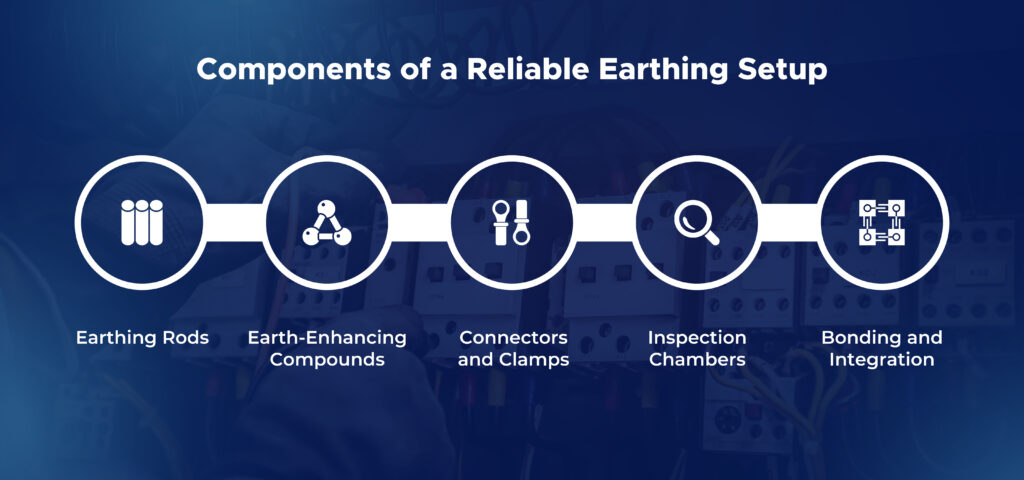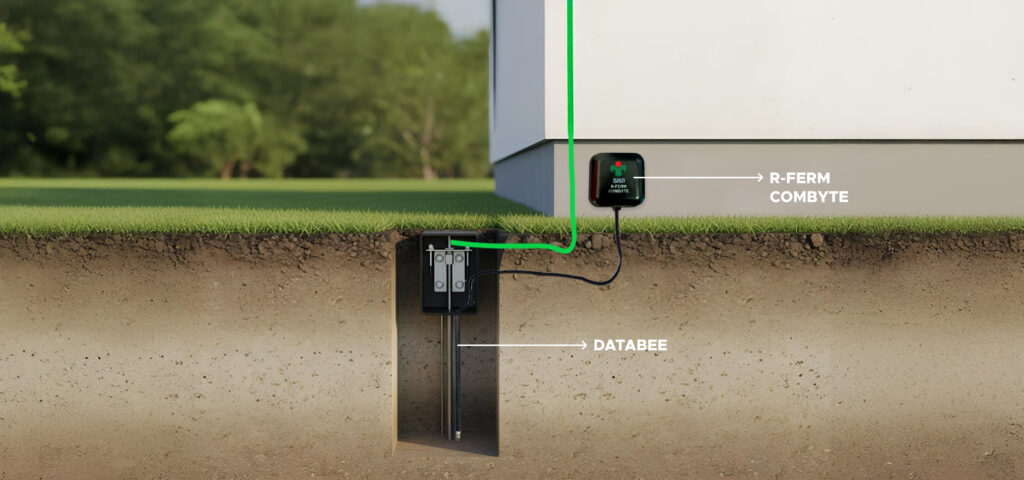In today’s modern homes, where everything from your refrigerator to your Wi-Fi router depends on a stable power supply, ignoring proper earthing can compromise the entire safety infrastructure. Electrical systems are only as safe as their grounding. The best earthing system for home ensures that excess electrical energy from faults or lightning is safely dissipated into the ground, protecting your family and appliances from shocks, fires, and failures.
An inadequate home earthing system can lead to dangerous voltage surges, equipment damage, and even life-threatening accidents. Many homeowners focus only on wiring quality or breakers, overlooking that earthing is the silent safety mechanism that keeps everything else reliable.
This blog will help you understand how to choose the best earthing system for home, the types available, how they work, and what factors to consider before installation. You’ll also learn about the components, installation process, maintenance, and common mistakes to avoid so that you can make an informed and safe choice for your property.
What is a Home Earthing System?
A home earthing system is a network of conductors designed to provide a low-resistance path for fault current to flow safely into the earth. When a fault occurs, such as a short circuit, insulation failure, or a lightning surge- the current takes the easiest path through the earthing rod for the home, rather than passing through people or equipment.
The core purpose of an earthing system is to ensure that all exposed conductive parts of the electrical installation remain at earth potential. This minimizes the risk of electric shocks and protects both life and property.
Typical home earthing system includes several key components:
- Grounding rod for house (or earthing rod for home), the electrode that physically contacts the soil.
- An earthing plate is used in some systems to provide a broader contact area.
- Conductors and clamps, connecting the earthing network.
- Inspection chambers, allowing access for testing.
- Earth-enhancing compounds improve soil conductivity and reduce resistance.
Think of it this way: Earthing System is the hidden guardian beneath your home, silently ensuring your safety every time you turn on a switch.
Types of Earthing Systems Used in Homes

Not all homes require the same earthing setup. Choosing the best earthing system for home depends on your location, soil conditions, space availability, and budget. Below are the most common types of home earthing systems:
- Rod Earthing: This is the most widely used system in residential installations. A grounding rod for a house, usually made of copper-bonded steel or solid copper, is driven deep into the ground to achieve a low earthing resistance value. It’s compact, cost-effective, and suitable for most soil types.
- Plate Earthing: Involves burying a copper or GI earthing plate horizontally in the ground. It provides a larger surface area for current dissipation and is ideal in locations where deep excavation for rods isn’t feasible.
- Pipe Earthing: This method uses a perforated GI pipe to allow moisture to maintain soil conductivity. It’s suitable for areas with high soil resistivity, especially in dry climates.
- Chemical Earthing: A modern solution where the electrode is surrounded by special compounds that retain moisture and reduce resistance over time. It provides long-term stability and requires minimal maintenance.
Understanding these systems helps you match your needs with the best earthing system for home, suited to your soil and structure.
Factors to Consider When Choosing the Best Earthing System
Selecting the best earthing system for home isn’t as simple as picking a rod or plate; it’s about understanding your environment and electrical requirements.
- Soil Resistivity: Soil type, moisture, and temperature have the greatest impact on earthing resistance value. Clay soils with high moisture content offer lower resistance, while rocky or sandy soils may require chemical enhancement or multiple electrodes.
- Resistance Value: For safety and compliance, the earthing resistance value of a home should ideally be below 5 ohms. Lower values indicate better performance and faster dissipation of fault current.
- Space Availability: Limited space favours plate or chemical earthing, while open plots can accommodate deep earthing rods for home.
- Electrical Load: Large homes with heavy electrical appliances, inverters, or EV chargers may need multiple grounding electrodes to ensure balanced protection.
- Environmental Conditions: Corrosive soil, coastal humidity, or dry weather can affect electrode life. In such cases, chemical earthing or copper-bonded rods are preferred.
- Compliance and Standards: Ensure your home’s earthing system complies with IS 3043, IEC 60364, and local electrical codes. Always request a soil resistivity test before installation—it’s the foundation for designing the best earthing system for home.
Components of a Reliable Earthing Setup

A robust earthing system for the home depends on the quality of its materials and the integrity of its installation.
- Earthing Rods – Choose between solid copper (for best conductivity and corrosion resistance) or copper-bonded steel (a cost-effective and durable option). The earthing rod for home should have adequate length and thickness to reach moist soil layers.
- Earth-Enhancing Compounds – Substances like bentonite, graphite, or proprietary mixes such as Curec+ and Curecon improve soil conductivity and stabilize resistance over time. They’re crucial in areas with dry or high-resistivity soil.
- Connectors and Clamps – Corrosion-resistant clamps made of copper or bronze ensure long-lasting electrical contact between conductors and electrodes.
- Inspection Chambers – These chambers enable easy testing and visual inspection without excavation, ensuring long-term reliability and easy access for maintenance.
- Bonding and Integration – All metallic parts, such as plumbing, structural steel, and electrical panels, must be bonded to the main earthing terminal. This ensures uniform potential and prevents dangerous voltage differences.
Each of these elements contributes to creating the optimal earthing system for the home, striking a balance between safety, durability, and performance for best earthing system for home.
Installation and Testing of Earthing System for Your Home

Installing the best earthing system for your home requires a structured and professional approach. Here’s how it typically works:
- Site and Soil Assessment: Experts analyze soil resistivity and determine optimal electrode placement.
- Electrode Selection: Depending on the results, a grounding rod for a house, plate, or chemical electrode is chosen.
- Excavation and Placement: The electrode is installed at a specific depth and surrounded by enhancing compounds.
- Bonding and Connections: Conductors link the electrode to the main distribution panel and other metallic components.
- Testing and Certification: Using an earth resistance meter, technicians verify that the earthing resistance value meets safety standards (ideally below 5 ohms).
A proper installation concludes with documentation and compliance reports, which are critical for insurance and safety validation.
Maintenance of Your Home Earthing System
Even the best earthing system for home requires periodic inspection. Over time, soil conditions, corrosion, and loose connections can increase resistance and reduce the system’s effectiveness.
Annual testing of the home earthing system ensures safety and reliability. The inspection chamber makes it easier to test without the need for excavation.
Watch for warning signs, such as frequent circuit breaker trips, mild shocks from appliances, or flickering lights; these may indicate deterioration of the grounding system. Regular maintenance ensures your earthing system continues protecting your home as intended.
The Role of Manav’s R-FERM in Preventing Earthing Failures

Traditional earthing systems in homes are often “fit-and-forget,” with little visibility into their real-time condition. However, poor or deteriorated earthing can lead to serious safety risks, from electric shocks to equipment damage and increased vulnerability during lightning or fault events.
Manav’s Remote Fault Time Earth Resistance Monitor (R-FERM) Technology provides intelligent monitoring for this critical yet often overlooked aspect of the electrical infrastructure. R-FERM continuously tracks the earth resistance value of residential grounding systems, even during transient fault conditions, and alerts users when thresholds are breached.
What sets R-FERM apart is its ability to detect degradation in grounding effectiveness before it becomes hazardous. Whether due to corrosion, moisture changes, soil displacement, or improper installation, any rise in earth resistance is flagged in real time, helping homeowners or facility managers take timely corrective action.
This proactive insight not only improves electrical safety but also ensures that protective devices (like breakers, surge protectors, and lightning arresters) function as intended during faults or lightning strikes.
As homes become increasingly reliant on sensitive electronics, rooftop solar systems, and smart appliances, a reliable earthing system is essential for best earthing system for home.
Common Mistakes to Avoid
Many homeowners unknowingly compromise their home earthing system by skipping essential steps. Here are common mistakes to avoid:
- Choosing the wrong system without testing soil resistivity can lead to significant problems.
- Using poor-quality earthing rods for home that corrode quickly.
- Ignoring the bonding between all metal parts and the main earthing point.
- Skipping earthing resistance value testing.
- Relying on unqualified or DIY installations.
These errors can lead to higher fault voltages, fire hazards, and non-compliance with electrical codes. The best earthing system for home is one that’s designed, installed, and maintained by certified professionals.
Conclusion
Your home’s electrical safety begins beneath your feet. The best earthing system for home doesn’t just protect appliances, it safeguards lives. A properly designed home earthing system ensures fault currents are safely discharged into the ground, preventing shocks, fires, and equipment damage.
Remember, it’s not just about picking a rod or plate; it’s about matching your soil, environment, and load conditions to the right system. Regular testing and professional installation ensure your earthing resistance value stays within safe limits.
Whether you’re building a new home or upgrading an existing setup, always consult qualified experts. Manav offers advanced, standards-compliant solutions that combine technical precision with long-term reliability. Choose right, stay grounded, and secure your home with the best earthing system for home, because safety begins where electricity ends.
– Author: Pankaj


